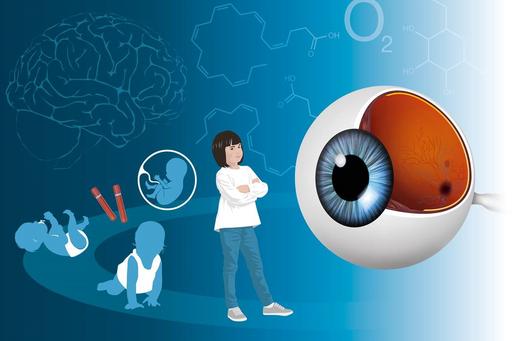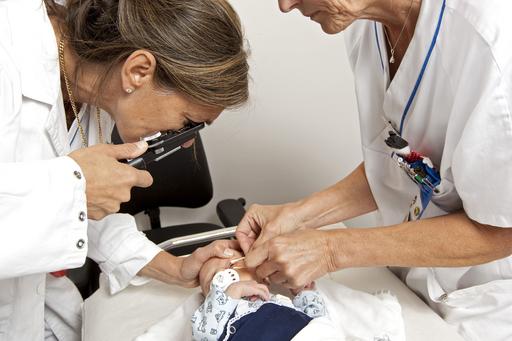
The Sahlgrenska Center for Pediatric Ophthalmology Research
Short description
The Sahlgrenska Center for Pediatric Ophthalmology Research at the Institute of Neuroscience and Physiology at the University of Gothenburg is a strategic research center focused on vascular and neural development research. Our center is based on partnerships between industry, clinical and experimental sciences as well as applied mathematics for development of prediction model.
News
- Wallenberg Clinical Scholars prolongation grants 2025 (External link)
- Preterm babies given certain fatty acids have better vision
- Risk of blindness among premature babies with low levels of blood platelets
- New discovery offers hope of protecting premature babies from blindness
- Halved risk for severe retinal disease in extremely premature infants
- Halved risk for severe retinal disease in extremely premature infants [Feb 2, 2…
- Ann Hellström appointed Wallenberg Clinical Scholar [March 19, 2019]
The center
The center is focused on defining the underlying mechanisms of vascular and neural damage occurring after preterm birth and to develop strategies to better diagnose and possibly prevent these life-threatening complications.
Our studies suggest a number of ways to intervene medically in these disease processes. Studies on the disease mechanisms and the development of strategies to allow normal retinal and brain development may ultimately lead to significant reduction in the short and long-term morbidity of preterm infants.
Methods
The laboratory facilities at the Sahlgrenska Center of Pediatric Ophthalmologic Research include a wide array of advanced laboratory and analytical methods, such as state-of-the-art molecular biology techniques and immunoassays, comprehensive metabolomic profiling via LC-MS/MS and GC-MS, advanced imaging and image analysis, and sophisticated statistical modeling and bioinformatics for data integration. Excellent animal facilities with full surgical equipment are available at the Department of Physiology at Experimental Biomedicine, enabling controlled in vivo studies. Furthermore, our extensive collaborative network within Europe and the USA provides access to cutting-edge proteomics, metabolomics, microbiome analysis, and next-generation sequencing.

Ongoing studies
Clinical studies
- A Randomized Intervention, Multi-Center Study to Determine the Role of Dexamethasone eye drops against proliferative retinopathy of prematurity. (DROPROP). EU CT #2023-505318-97-00 https://euclinicaltrials.eu/
- A clinical trial – Less is more (LIM) reducing the amount of blood taken for tests from extremely preterm infants
- Epitop: a neonatal biobank saving leftover clinical bloodsamples.
- Preservation of Blood in Extremely Preterm Infants (LIM)
https://clinicaltrials.gov/study/NCT04239690 - A clinical trial (Mega Donna Mega) to investigate the impact of AA/DHA on retinopathy, visual and neural development www.clinicaltrials.gov #NCT03201588
- A clinical trial (Donna Mega) to investigate the impact of DHA/EPA on retinopathy, visual and neural development EudraCT no 2008-000046-31
- A clinical trial (phase II study) with IGF-I/IGFBP-3 administration www.clinicaltrials.gov NCT 01096784
- Further validation of WINROP® (national & international)
- Ophthalmologic follow-up studies of infants with perinatal adverse history
- Investigating the impact of postnatal serum IGF-I levels on preterm morbidity and postnatal growth
- Effect of blood components importance for neuro- and angiogenesis in premature infants
- Metabolic and Pharmacokinetic analysis of intravenous insulin administration to very preterm infants
- Development of a digital e-health solution for ROP screening and diagnosis
- Development of predictions models (DIGIROP-birth and DIGIROP-screen) for individualised risk for ROP needing treatment.
Experimental studies
- Investigating the impact of chronic inflammation on ROP development in an experimental neonatal animal model
- A proteomic and Luminex approach for identification of biomarkers in amnion, cord blood and serum that may predict an increased risk for ROP
- Studies of platelet mitocondria in preterm and full term babies in collaboration with Lund University.

Principal Investigator
Ann Hellström
MD, PhD, Professor
Group members
Anders Nilsson, PhD
Chatarina Löfqvist, PhD, Associate Professor
Anna-Lena Hård, MD, PhD
Gunnel Hellgren, PhD, Associate Professor
Pia Lundgren, MD, Associate Professor
William Hellström, MD, PhD
Carola Pfeiffer Mosesson, RN, Monitor
Aldina Pivodic, PhD
Karin Sävman, MD, PhD
Lena Jacobson, MD, PhD, Associate Professor
Hanna Danielsson, MD, Doctoral Student
Dirk Wackernagel, MD, Senior Consultant
Ulrika Sjöbom, PhD
Malin Hansson, PhD
Jenny Wallander, MD, Doctoral Student
Mohit Panwar, BSc, Doctoral Student
Tove Hellqvist, BMA
Liv Vallin, MD, Doctoral Student
Hanna Gyllensten, Associate Professor
Martin Törn, Student
Alma Borgarsdottir, Doctoral Student
Prediction WINROP/DIGIROP-birth
WINROP® history
We have done extensive laboratory work showing that insulin like growth factor 1 (IGF-1) which mediates growth is a major factor in the development of ROP (Hellström A et al Proceedings of the National Academy of Sciences, 2001).
Based on that finding we developed and published an algorithm WINROP® based on serial neonatal measurements of body weight, which predicts ROP development. The original article including IGF measurements prompted an editorial in Archives of Ophthalmology “Screening for Retinopathy of Prematurity- The Promise of New Approaches”.
DIGIROP-birth
DIGIROP-birth is an individualized prediction model for the risk of ROP treatment developed by Aldina Pivodic. It is freely available at digirop.com.
Swedish National Patient Registry data from infants screened for ROP (2007–2018) were analyzed with Poisson regression for time-varying data (gestational age (GA), postnatal age, birth weight, sex and important interactions), to develop an individualized predictive model for ROP treatment, DIGIROP-Birth. The model was validated, internally, and externally (US and European cohorts), and compared to four published prediction models.
The studied outcome was ROP treatment. The measures are estimated momentary and cumulative risks, hazard ratios with 95% confidence intervals, area under the receiver operating characteristic curve (AUC), sensitivity, specificity, positive (PPV) and negative predictive value (NPV).
Among 7,609 infants, GA 28.1 (SD 2.1) weeks, weight 1119 (SD 353) g, 3454 (45.4%) girls, 442 (5.8%) were treated for ROP, 142 (40.1%) of those born <24 gestational weeks. Irrespective of GA, the risk for receiving ROP treatment increased during postnatal weeks 8–12 (HR, 1.54/week; 95% CI, 1.39 to 1.70); thereafter, it decreased (HR, 0.70/week; 95% CI, 0.67 to 0.74). Validations of DIGIROP-Birth for GA 24–30 weeks showed high predictive ability for the model overall (AUC: internal 0.90, temporal 0.94, US external 0.87, European external 0.90), by calendar periods and by race/ethnicity. The sensitivity, specificity, PPV and NPV were numerically at least as high as those obtained from CHOP-ROP, OMA-ROP, WINROP and CO-ROP, models requiring more complex data.
We validated an individualized prediction model, GA 24-30 weeks, enabling early risk prediction of ROP treatment based on birth characteristics data. Postnatal age rather than postconceptional age was a better predictive variable for the outcome. The model is generalizable, accessible through an application (www.digirop.com) and has at least as good test statistics as other models requiring longitudinal neonatal data not always available for ophthalmologists.
Winrop application
If you want to apply for WINROP®, visit www.winrop.com
WINROP® is free of charge.
Prevention IGF-I
We have previously demonstrated that low levels of serum IGF-1 and IGFBP-3 in children born preterm are strongly associated with ROP as well as other morbidities in preterm infants (e.g. poor growth, lung disease and poor brain development).
Based on these results we have clinically investigated the concept of restoring IGF-1/IGFBP-3 to in utero levels in premature infants. We have conducted and finalized a Phase I, pharmacokinetic study of intravenously administered rhIGF-I/rhIGFBP-3 complex (mecasermin rinfabate) to five very preterm children (GA 26-29 weeks). No side effects (b-glucose, heart rate, blood pressure) were seen and the dose and mode of delivery was established for Phase II study (Hellström A et al Ped Res 2009) (Ley D et al Ped Res 2013).
Carrying out this project is a major multi-disciplinary project with many participants, contributing with a broad range of competences, involved. For a successful implementation of the project, national and international experts in ophthalmology, neonatology, pharmacokinetics, pharmaceutics, GMP (Good Manufacturing Practice), GCP (Good Clinical Practice), GLP (Good Laboratory Practice) are needed. The Phase II study is an international multi-center trial with participation from the neonatal clinics in Lund and Stockholm.
The pharmaceutical company, Premacure AB, Uppsala, Sweden now acquired by Shire®, is coordinating all activities before, during and after the trial and is also in charge of obtaining all regulatory authorizations before the study can commence. Pharma Consulting Group AB (PCG), Uppsala, Sweden has been contracted as independent monitor of the study. This will guarantee that the work is carried out in accordance with the regulatory provisions (GCP).
As we are focusing on factors that promote neural, vascular and metabolic development, our findings regarding ROP are likely to be applicable on several aspects of complications of premature birth and will hopefully provide benefits for the whole lifespan.
Prevention Fatty Acids
Extremely preterm (EPT) infants have a high incidence of neonatal morbidities including retinopathy of prematurity (ROP), a neurovascular disease with initial suppression of retinal blood-vessel growth, followed by pathologic neovascularization that can cause blindness. Treatment of severe ROP aims to cause regression of pathologic neovascularization and prevent retinal detachment by reducing the action of vascular endothelial growth factor (VEGF). Laser therapy is performed under general anesthesia and destroys the hypoxic VEGF producing peripheral retina. Anti-VEGF therapy comprises of intraocular injections, often repeated, of antibodies against VEGF. These substances enter the circulation and concerns for their effects on growing tissues have been raised. ROP correlates with reduced brain volumes and poor psychomotor development.
Infants born EPT, miss the third trimester transfer from the mother of the n-6 long chain polyunsaturated fatty acid (LCPUFA) arachidonic acid (AA) and the n-3 LCPUFA docosahexaenoic acid (DHA). AA and DHA are critical constituents of the retina and the brain and deficiencies associate with vascular complications of preterm birth. AA lipid fraction is two-fold higher in fetal than maternal blood throughout gestation while DHA fraction is similar to the maternal fraction until ~30 weeks gestational age (GA), then increases concomitant with rapid brain growth. Lipid emulsions currently used in parenteral nutrition contain insufficient or no AA and DHA. Breastmilk does not provide enough AA and DHA to fulfil the early requirements of EPT infants. Thus, EPT infants accumulate AA and DHA deficits during hospitalization.
Several studies suggest that low n-3 LCPUFAs are associated with ROP risk. Increased intake of n-3 protected against pathologic neovascularization in mouse oxygen induced retinopathy.
A few studies have been performed using enteral DHA supplementation early after birth to preterm infants. A reduction in stage 3 ROP was found in infants with birth weight 1000-1500g receiving enteral DHA for 14 days. The primary aim of this trial is to study the frequency of severe (stage 3 and/or type 1) ROP with and without AA:DHA supplementation. Secondary aims were to investigate the effects of AA:DHA supplementation on serum phospholipid fatty acid composition and rate of other complications of prematurity. This study adds to current knowledge by studying the effects of an enteral lipid supplement containing both AA and DHA to extremely preterm infants stratified into GA-based groups.
In this project outcomes will be neonatal morbidities, MRI at term, proteomics, metabolomics, nutritional impact on outcomes and long term follow-up at 2.5 and 5 years of age, www.clinicaltrials.gov # NCT03201588



